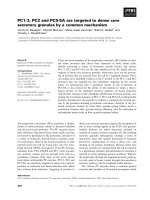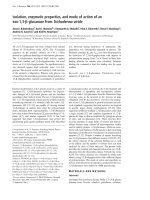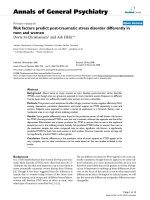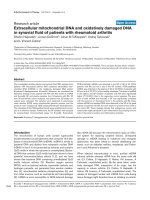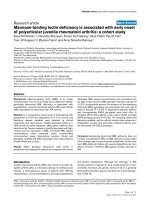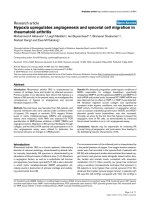Báo cáo y học: "Road traffic accidents and posttraumatic stress disorder in an orthopedic setting in south-eastern Nigeria: a controlled study" doc
Bạn đang xem bản rút gọn của tài liệu. Xem và tải ngay bản đầy đủ của tài liệu tại đây (232.61 KB, 6 trang )
ORIGINAL RESEARCH Open Access
Road traffic accidents and posttraumatic stress
disorder in an orthopedic setting in south-eastern
Nigeria: a controlled study
Obiora Iteke
1*
, Muideen O Bakare
2
, Ahamefule O Agomoh
3
, Richard Uwakwe
4
and Jojo U Onwukwe
5
Abstract
Background: Psychiatric liaison services are rare in trauma units of various hospitals in Nigeria and other sub-
Saharan African countries. The occurrence of road traffic accidents (RTAs) resulting from low standard of road
construction and inadequate maintenance have been on the increase in Nigeria. While the physical consequences
of such RTAs are obvious, the psychological consequences are often not apparent. This study assessed the
prevalence of posttraumatic stress disorder (PTSD) among victims of RTAs and compared same with controls
drawn from a population who have not experienced RTAs. It also assessed the associated socio-demographic
variables.
Method: Study population consisted of one hundred and fifty RTA victims and two different control groups drawn
from the population consisting of staffs of Federal Neuropsych iatric Hospital, Enugu, Nigeria and that of National
Orthopedic Hospital, Enugu, Nigeria, 150 people in each control group were matched for age and sex with the
RTA victims and they were interviewed with PTSD module of Mini International Neuropsychiatric Interview (MINI)
and their socio-demographic variables obtained with socio-demographic questionnaire.
Results: The prevalence of PTSD among RTA victims and the two control groups were 26.7%, 8.0% and 8.7%
respectively. The difference in prevalence was statistically significant with RTA victims m ore likely to experience
PTSD compared to the two control groups (X
2
= 27.23, df = 2, p = 0.001). Gender influenced the prevalence of
PTSD among victims of RTAs and the controls, with females more likely to experience PTS D when compared to
the males. Among victims of RTAs, being gainfully employed prior to the accidents increased the likelihood of
developing PTSD and this was statistically significant (X
2
= 20.09, df = 1, p = 0.000).
Conclusions: There is urgent need to pay more attention to developing consultation-liaiso n psychiatry services in
trauma units of Nigerian hospitals, including orthopedic hospitals located in different geographical zones of the
country.
Background
Developing countries, of which sub-Saharan African
countries are inclusive, have been known to face double
burden of diseases [1,2]. Poor governance and corrupt
practices in most sub-Saharan African countries had led
to poor standards in construction and maintenance of
social amenities like roads amongst others. There have
been many cases of road traffic accidents (RTAs)
resulting from low construction standards and poor
road maintenance [3,4].
Avoidable road traffic accidents among other accidents
have continued to add to morbidity and mortality in
most sub-Saharan African countries. It appears like
most sub-Saharan African countries are then experien-
cing another disease burden from the preventable acci-
dents resulting from poor road infrastructure. It may
therefore not be out of place to talk of a triple burden
of disease. The issue of road traffic accidents is reaching
an alarming state in Nigeria where Federal Road Safe ty
Corps (FRSC) has continued to report increased preva-
lence in road traffic accidents on a yearly basis [4].
* Correspondence:
1
General Adult Psychiatry Unit, Federal Neuropsychiatric Hospital, New
Haven, Enugu, Enugu State, Nigeria
Full list of author information is available at the end of the article
Iteke et al. Scandinavian Journal of Trauma, Resuscitation and Emergency Medicine 2011, 19:39
/>© 2011 Iteke et al; licensee BioMed Central Ltd . This is an Open Access article distributed under the terms of the Creative Commons
Attribution License ( which permits unres tricted use, distribution, and reproduction in
any medium, provided the original work is properly cited.
The inclusion of motorcycles in Nigeria as a means of
commercial transportation has added to the likelihood
occurrence of these road traffic accidents (RTAs) [5].
Frequent injuries susta ined in most of the reported
RTAs included bone fractures, which are often treated
in specialized orthopedic hospitals in this environment.
While the physical consequences of these RTAs are
apparent in soft tissue injuries a nd bone fractures [5],
psychological consequences such as PTSD amongst
others are not easily obvious. Less attention has there-
fore been paid to the psychological consequences of
RTAs in Nigeria where the prevalence has been reported
to be on the in crease [4,5]. While many literatures from
other parts of the world had addressed issue of posttrau-
matic stress disorder complicating road traffic accidents
and other traumas, such information are largely unavail-
able in sub-Saharan Africa. In other parts of the world,
the prevalence of posttraumatic stress disorder after
road traffic accidents range between 8.5% and 39% [6-9].
There had been inconsistent report on socio-demo-
graphic factors associated with developing posttraumatic
stress disorder following traumatic events. Only factor
of gender appeared to have been consi stent in most
reports, with female gender of ten more prone to devel-
oping symptoms of posttraumat ic stress disorder after
traumatic events [6-9].
Despite the potential psychological consequences of
road traffic accidents, liaison psychiatry services are rare
practices in various orthopedic hospitals and trauma
units of other hospitals in Nigeria.
This study therefore assessed the prevalence of PTSD
among injured victims of RTAs in an orthopedic setting
in South Eastern Nigeria and compared same to
matched group of individuals from the general popula-
tion, r andomly chosen from staffs of Federal Neuropsy-
chiaric Hosital, Enugu, Nigeria and that of National
Orthopedic Hospital, Enugu, Nigeria. It also assessed
associations between PTSD and various socio-demo-
graphic variables.
Methods
Thelocationofthestudywastheout-patientunitof
National Orthopedic Hospital Enugu (NOHE), Nigeria.
This hospital, which was established in 1975, has a total
of ten wards. The bed capacity of the hospital is about
two hundred and twenty (220). The hospital provides
specialist medical care to pati ents in South Eastern
States of Nigeria.
Permission to conduct the study was obtained from
the Institutional Review Board (IRB) of Federal Neurop-
sychiatric Hospital, Enugu, (FNHE), Nigeria and the
Research, Education and Training (RET) unit of
National Orthopedic Hospital, Enugu, (NOHE ), Nigeria.
Those identified with PTSD were referred to Federal
Neuropsychiatric Hospital Enugu, (FNHE), Nigeria for
further evaluation and management.
Sample population
The study population consisted of 150 injured victims of
RTAs,aged18yearsandabovewhowereattendingthe
out-patient unit of the National Orthopedic Hospital
Enugu (NOHE), Nigeria for follow up treatment from
September to December 20 08. Consecutive injured RT A
victims who gave informed consent were interviewed.
Patients with history of head injury during the RTAs
were excluded from the study.
The controls were selected from staffs of National
Orthopedic Hospital, Enugu (NOHE), Nigeria and Fed-
eral Neuropsychiatric Hospital Enugu (FNHE), Nigeria.
The two hospitals are located within Enugu metropolis.
The controls had not been involved in RTAs.
Because the staffs of National Orthopedic Hospital,
Enugu (NOHE), Nigeria were more prone to witnessing
injured victims of RTAs being brought to the hospital, it
was hypothesized that they could also be prone to devel-
oping post-t raumatic syndrome and stress disorder. For
this reason, a second control group was considered for
the study. Thus, 150 individuals from staffs of Federal
Neuropsychiatric Hospital, Enugu (FNHE), Nigeria and
150 individuals from staffs of National Orthop edic Hos-
pital, Enugu (NOHE), Nigeria served as control groups
1 and 2 respectively. Therefore, the total population stu-
died was 450 people.
The control subjects were select ed rand omly from list
of staffs of National Orthopedic Hospital, Enugu
(NOH E), Nigeria and Federal Neuropsychi atric Hospital
Enugu (FNHE), Nigeria. They were matched for age and
sex with the study group.
Materials
Socio-demographic Questionnaire
A sociodemographic questionnaire was used to elicit
such variables as age, sex, marital status, religion, educa-
tional level, occupation and the time since the road tra f-
fic accidents occurred among the study subjects.
Mini International Neuropsychiatric Interview (M.I.N.I)[10]
This is a short structured in terviewer administered diag-
nostic instrument, developed for assessing psychiatric
disorders based on DSM-IV and ICD-10 diagnostic cri-
teria [10].
Procedure
Consecutive outpatient attendees who are injured vic-
tims of RTA whose accidents occurred not earlier than
one month and not later t han twelve months before
thestudywereintervieweduntilthesamplesizewas
met.
Iteke et al. Scandinavian Journal of Trauma, Resuscitation and Emergency Medicine 2011, 19:39
/>Page 2 of 6
The outset exclusion criteria included, patients who
did not consent to the study, patients who sustained
head injury following the RTAs and patients whose
RTAs had not lasted for more than one month. How-
ever, none of the patien ts approached for interview
refused to give consent. Pat ients with h ead injury were
excluded because they could develop neurological com-
plications that might introduce bias into the outcome of
the study. This group of patients with head injury con-
stituted less than ten percent of the total out-patients
population.
Consecutive out-patients attendees that met the inclu-
sion criteria for the study were administered socio-
demographic questionnaire to elicit variab les such as
age, sex, marital status, educational level, occupation
and time when the RTA occurred.
As all subjects studied were fluent in English language,
they were interviewed with the E nglish version of PTSD
module of the Mini International Neuropsychiatric
Interview (M.I.N.I) [10] to make a diagnosis of PTSD.
The control subjects matched for age and sex to the
study subjects were also interviewed with the PTSD
module of the M.I.N.I instrument.
Data analysis
The data were analyzed using the Statistical Package for
Social Sciences (SPSS), version 16. Prevalence of post-
traumatic stress disorder in each group was determined.
Analysis of variance (ANOVA) and chi-square statistics
was used to compare the three groups studied on socio-
demo graphic variables. Chi-square statistics was used to
test association between presence of posttraumatic stress
disorder and socio-demographic variables.
Results
There were four hundred and fifty (450) participants
interviewed. One hundred and fifty (150) injured victims
of road traffic accidents, one hundred and fifty (150)
participants in the first control group and one hundre d
and fifty (150) participants in the second control group
selected from staffs of FNHE and NOHE, Nigeria who
had not been involved in RTAs.
Socio-demographic variables of the victims of road traffic
accidents and the two control groups
Age
Theagerangeofthevictimsofroadtrafficaccidents
was 18 to 57 years, and the mean age was 31.61 ± 9.18
years.
The first contro l group had an age range of 18 to 56
years with a mean age of 32.14 ± 8.85 years, while the
second control group had an age range of 19 to 57
years with a mean age of 33.01 ± 8.95 years.
Gender
The victims of road traffic accidents consisted of 108
(72.0%) males and 42(28.0%) females. The first control
group consisted of 10 8(72.0%) males and 42(28.0%)
females, while the second control group consisted of
108(72.0%) males and 42(28.0%) females.
Marital status
Fifty-nine (39.3%) of the injured victims of road traffic
accidents were married while 91(60.7%) were single. In
the first control group, 85(56.7%) were married, 64
(42.7%) were single a nd 1(0.7%) was widowed. For the
second control group 95(63.3%) were married and 55
(36.7%) were single.
Religion
All of the victims of road traffic accidents and the two
control groups were Christians.
Level of education
Educational attainment was grouped into those with ter-
tiary education and those with below tertiary education.
Levels of education in Nigeria are divided into primary,
secondary and tertiary. Below tertiary education as used
here referred to secondary school education and below,
while tertiary education as used here referred to post-
secondary school education. One hundred (66.7%) of the
injured victims of road traffic accidents had education al
level below tertiary, while 50(33.3%) had tertiary
education.
In the first control group, 45(30.0%) participants had
below tertiary education while 105(70.0%) attained ter-
tiary level of education. For the second control group,
39(26.0%) had below tertiary education while 111(74.0%)
had tertiary education.
Employment status
Among the victims o f road traffic accidents, 89(59.3%)
were employed while 61(40.7%) were unemployed. Parti-
cipants in both the first and second control groups were
all employed.
Comparison of the three groups on the socio-demographic
variables
Using one-way analysis of variance (ANOVA), there was
no statistical significant differenc e in the mean age of
the RTA victims and the control groups (F-ratio = 0.92 ,
p = 0.400). There was also no statistical significant dif-
ference in s ex distribution among the three groups of
RTA victims and the control groups (X
2
= 0.00, df = 2,
p = 1.000). The samples were however different in the
distribution of their marital status with those in the con-
trol groups being more married than the victims of RTA
(X
2
= 20.70, df = 4, p = 0.000). They were also d ifferent
in the distribution of their level of education with those
in the control groups attaining tertiary level of education
compared to the victims of RTA (X
2
= 62.36, df = 2, p =
0.000). All the participants in the control groups were
Iteke et al. Scandinavian Journal of Trauma, Resuscitation and Emergency Medicine 2011, 19:39
/>Page 3 of 6
employed. Table 1 showed the socio-de mographic vari-
ables of the RTA victims and the control groups.
Prevalence and distribution of PTSD among victims of road
traffic accidents and the controls
Among the 150 road traffic accident victims interviewed,
forty (26.7%) experienced PTSD while 110(73.3%) did
not experience PTSD. In the first control group from
the general population (i.e. Staffs of Federal Neuropsy-
chiatric Hospital Enugu, Nigeria) 12(8.0%) experienced
PTSD while 138(92.0%) did not experience PTSD. For
the second control group from the general population (i.
e. Staffs of National Orthopedic Hospital Enugu,
Nigeria) 13(8.7%) ex perienced PTSD wh ile 137(91.3%)
did not experience PTSD. The victims of RTA were
more likely to experience PTSD compared to people in
either of the two control groups. (X
2
= 27.23, df = 2, p
= 0.001). See Table 1.
Socio-demographic variables and prevalence of PTSD
among victims of RTA and the controls
Gender
Among the victims of RTA, 16 females which repre-
sented 38.0% of the total female population in this
group experienced PTSD when compared to 24 males
that represented 22.2% of the male population. The dif-
ference in prevalence of PTSD was statistically signifi-
cant with females being more likely to experience PTSD
(X
2
= 3.74, df = 1, p = 0.05). See Table 1.
In the first control group, 6 females which represented
14.3% of the female population experienced PTSD, while
6 males which represented 5.6% of the male population
experienced PTSD. More females compared to males in
this group were likely to experience PTSD, but the dif-
ference was not statistically significant (X
2
=2.84,df=
1, p = 0.09).
In the second control group, 7 females which repre-
sented 16.7% of the f emale population e xperienced
PTSD, while 6 males that represented 5.6% of the male
population experienced PTSD. The difference was statis-
tically significant with females being more likely to
experience PTSD when compared to males (X
2
= 4.24,
df = 1, p = 0.04). See Table 1.
Employment status
Out of a total of 40 individuals (26.7%) who had PTSD
among the victims of RTA, 35 individuals who repre-
sented 23.3% prevalence of PTSD were gainfully
employed prior to the accidents, while 5 individuals who
represented 3.3% prevalence of PTSD were unemployed.
The difference was statistically significant with those
whowereemployedmorelikelytoexperiencePTSD
compared to those who w ere unemployed (X
2
= 20.09,
df = 1, p = 0.000). Gainfully employed prior to the
RTAs was defined by the individual concerned having a
source of income and independent; either being self
employed, employed by the government or private
establishments. The two control groups could not be
Table 1 Socio-demographic variables of the victims of road traffic accidents and the two control groups
Socio-demographic variables Road Traffic Accident Victims
N(%)
Control Group 1 (FNHE staffs)
N (%)
Control Group 2(NOHE staffs)
N (%)
Statistics
Mean age 31.61 ± 9.18 32.14 ± 8.85 33.01 ± 8.95 F = 0.918
p = 0.400
Gender:
Male 108(72.0%) 108(72.0%) 108(72.0%) X
2
= 0.000
df = 2
Female 42(28.0%) 42(28.0%) 42(28.0%) p = 1.000
Marital Status:
Married 59(39.3%) 85(56.7%) 95(63.3%) X
2
= 20.698
Single 91(60.7%) 64(42.7%) 55(36.7%) df = 4
Widowed 0(0.0%) 1(0.7%) 0(0.0%) p = 0.000
Religion:
Christianity 150(100.0%) 150(100.0%) 150(100.0%)
Level of Education:
Below tertiary 100(66.7%) 45(30.0%) 39(26.0%) X
2
= 62.355
df = 2
Tertiary 50(33.3%) 105(70.0%) 111(74.0%) p = 0.000
Employment Status:
Employed 89(59.3%) 150(100.0%) 150(100.0%)
Unemployed 61(40.7%) 0(0.0%) 0(0.0%)
FNHE - Federal Neuropsychiatric Hospital, Enugu, Nigeria
NOHE - National Orthopedic Hospital, Enugu, Nigeria
Iteke et al. Scandinavian Journal of Trauma, Resuscitation and Emergency Medicine 2011, 19:39
/>Page 4 of 6
comparatively compared on this demographic variable
because individuals in the two control groups were staffs
of two government hospitals in Enugu metropolis,
south-eastern Nigeria (FNHE and NOHE). See Table 1.
Other socio-demographic variables
Other socio-demographic variables such as age, marital
status and l evel of education did not show significant
influence on the prevalence of PTSD among the victims
of RTA and the two control groups.
Discussion
The findings of this study revealed that injured road
traffic accident victims had higher prevalence of PTSD
compared to the two control groups who did not
experience RTA.
Female victims of road traffic accidents experienced
PTSD more than the male victims of road traffic acci-
dents. Those who were empl oyed among the victims of
road traffic accidents e xperienced PTSD more than
those who were not employed. In the first control group
from the general population, females experienced PTSD
more than the males. In the second control group from
the general population, females also experienced PTSD
more than the males.
TheprevalenceofPTSDamongthevictimsofRTAs
in this study was found to be 26.7%. This compares
with that of some previous study carried out in orthope-
dic hospitals [11,12]. The findings also agreed with that
of Shalev et al [13] who reported a PTSD prevalence of
about thirty percent at one month, about seventeen per-
cent at four months among trauma victims.
In the first control group, there was 8.0% prevalence
of PTSD while in the second control group it was 8.7%.
These findings are consistent with p revious reports of
PTSD prevalence among United States of America gen-
eral population in which Breslau et al [14] a nd Kessler
et al [15] reported a PTSD prevalence of eight to nine
percent.
Among the victims of RTA and the control groups,
there was consistent finding of females experiencing
PTSD more than the males. This agreed with previous
studies by Breslau et al [14] and Resnick et al [16]. It
had been reported that men and women have different
ways of responding to danger and expressing distress
[17]. During traumatic events, females use dissociative
defense mechanism more than males [18]. Females and
males also have different self-schemas and world-sche-
mas following exposure to similar traumatic events [19].
The findings that women have more negative self-sche-
mas and world-schemas may be consistent with the
increased diagnosis of PTSD in the women [20].
In this study, those who had gainful employment
before the RTA experienced PTSD more than the
unemployed. This agrees with the reports of another
study of RTA victims in which it was found that PTSD
scores on Structured Clinical Interview for DSM-IV
diagnosis (SCID) were significantly and positively asso-
ciated with loss of job activity due to the accident [21].
Disruption of b usiness and job activities with probable
attendant financial difficulties among the injured victims
of RTAs may have led to catastrophic appraisal of the
future. Post-trauma factors li ke financial difficulties have
been reported to be independently associated with
symptoms of posttraumatic stress disorder [22]. This is
more important in the environment of Sub-Saharan
Africa where patronage for insurance is very limited.
Conclusions
The findings of this study point to the need for promot-
ing development of consultation-liaison psychiatry ser-
vices in trauma units of Nigerian hospitals, including
orthopedic hospitals in different geographical zones of
the country. Government policies aimed at improving
standards of road construction and maintenance in
order to forestall avoidable road traffic accidents are
advocated in sub-Saharan African sub-region.
Acknowledgements
Authors acknowledged the cooperation of every individual that participated
in this study.
Author details
1
General Adult Psychiatry Unit, Federal Neuropsychiatric Hospital, New
Haven, Enugu, Enugu State, Nigeria.
2
Child and Adolescent Unit, Federal
Neuropsychiatric Hospital, New Haven, Enugu, Enugu State, Nigeria.
3
Forensic Psychiatry Unit, Federal Neuropsychiatric Hospital, New Haven,
Enugu, Enugu State, Nigeria.
4
Department of Mental Health, Nnamdi Azikiwe
University Teaching Hospital, Nnewi, Anambra State, Nigeria .
5
Community
Psychiatry Unit, Federal Neuropsychiatric Hospital, New Haven, Enugu, Enugu
State, Nigeria.
Authors’ contributions
All authors were involved in the conception of the study. OI participated in
data collection and wrote the initial draft of the Manuscript. OI, MOB and
AOA analyzed the data. All authors were involved in revision of the
Manuscript. All authors read and approved the final draft of the Manuscript.
Competing interests
The authors declare that they have no competing interests.
Received: 20 January 2011 Accepted: 22 June 2011
Published: 22 June 2011
References
1. Marshal SJ: Developing countries face double burden of disease. Bull
World Health Organization 2004, 82(7):556.
2. Maher D, Smeeth L, Sekajugo J: Health transition in Africa: practical policy
proposals for primary care. Bull World Health Organization 2010,
88(12):943-948.
3. Nwadiaro HC: Road Traffic Accident in Nigeria:a major catastrophe.
Journal of Medicine in the Tropics 2004, 6(2):1-7.
4. Federal Road Safety Commission: Nigerian traffic accidents (January to
October, 2009). FRSC Report 2009.
5. Labinjo M, Juillard C, Kobusingye OC, Hyder AA: The burden of road traffic
injuries in Nigeria: results of a population based survey. Injury Prevention
2009, 15:157-162.
Iteke et al. Scandinavian Journal of Trauma, Resuscitation and Emergency Medicine 2011, 19:39
/>Page 5 of 6
6. Mayou R, Bryant B, Duthie R: Psychiatric consequences of road traffic
accidents. British Med Journal 1993, 307:6447-651.
7. Blanchard E, Hickling E, Taylor A, Loos W: Psychiatric morbidity associated
with motor vehicle accident. J Nerv Ment Dis 1995, 183:495-504.
8. Schnyder U, Moergeli H, Klaghofer R, Buddeberg C: Incidence and
prediction of posttraumatic stress disorder symptoms in severely injured
accident victims. Am J Psychiatry 2001, 158:594-599.
9. Seethalakshmi R, Dhavale HS, Gawande S, Dewan M: Psychiatric morbidity
following motor vehicle crashes: a pilot study from India. J Psychiatr Pract
2006, 12(6):415-418.
10. Sheehan DV, Lecrubier Y, Sheehan KH, Amorim P, Janavs J, Weiller F,
Herguetal T, Baker R, Dunbar GC: The Mini-International Neuropsychiatry
Interview (M.I.N.I): the development and validation of a structured
diagnostic psychiatric interview for DSM-IV and ICD-10. J Clin Psychiatry
1998, 59(Suppl 20):22-23, quiz 34 - 57.
11. Ozaltin M, Kaptanoglu C, Aksaray G: Acute stress disorder and
posttraumatic stress disorder after motor vehicle accident. Turk Psikiyatri
Derg 2004, 15(1):16-25.
12. Koren D, Arnon I, Klein E: Acute stress response and posttraumatic stress
disorder in traffic accident victims: one year prospective follow up
study. Am J Psychiatry 1999, 156:367-373.
13. Shalev AY, Freedman S, Peri T, Brandes D, Sahar T, Orr SP, Pitman RK:
Prospective study of posttraumatic stress disorder and depression
following trauma. Am J Psychiatry 1998, 155(5):630-637.
14. Breslau N, Davis G, Peterson E, Andreski P: Traumatic events and
posttraumatic stress disorder in an urban population of young adults.
Arch Gen Psychiatry 1991, 48:216-222.
15. Kessler RC, Sonnega A, Bromet E, Nelson CB: Posttraumatic stress disorder
in National Comorbidity Survey. Arch Gen Psychiatry 1995, 52:1048-1060.
16. Resnick HS, Kilpatrick DG, Dansky BS, Saunders BE, Best CL: Prevalence of
civilian trauma and posttraumatic stress disorder in representational
national sample of women. J Consult Clin Psychol 1993, 61(6):984-991.
17. Punaki RL, Komproe IH, Quota S, Elmasri MJ: The role of peritraumatic
dissociation and gender in the association between trauma and mental
health in a Palestinian community sample. Am J Psychiatry 2005,
162:545-551.
18. Olff M, Langeland W, Draijer N, Gerson BP: Gender differences in
posttraumatic stress disorder. Psychol Bull 2007, 133(2):183-204.
19. Tolin DF, Foa EB: Gender and PTSD: A cognitive model. In Gender and
PTSD. Edited by: Kimerling R, Ouimette P, Wolfe J. New York: Guilford Press;
2002:76-97.
20. Breslau N, Kessler R, Chilcoat H, Davis G, Andreski P:
Trauma and
posttraumatic stress disorder in the community: the 1996 Detroit area
survey of trauma. Arch Gen Psychiatry 1998, 55:626-632.
21. Coronas R, Garcia-Pares G, Viladrich C, Santos JM, Menchon JM: Clinical and
sociodemographic variables associated with the onset of posttraumatic
stress disorder in road traffic accidents. Depress Anxiety 2008, 25(5):E16-23.
22. Riviere S, Schwoebel V, Kapierre-Duval K, Guinard A, Cardette V, Lang T:
Predictors of symptoms of posttraumatic stress disorder after the AZF
chemical factory explosion on 21 September 2001, in Toulouse, France.
Journal of Epidemiology and Community Health 2008, 62:455-460.
doi:10.1186/1757-7241-19-39
Cite this article as: Iteke et al.: Road traffic accidents and posttraumatic
stress disorder in an orthopedic setting in south-eastern Nigeria: a
controlled study. Scandinavian Journal of Trauma, Resuscitation and
Emergency Medicine 2011 19:39.
Submit your next manuscript to BioMed Central
and take full advantage of:
• Convenient online submission
• Thorough peer review
• No space constraints or color figure charges
• Immediate publication on acceptance
• Inclusion in PubMed, CAS, Scopus and Google Scholar
• Research which is freely available for redistribution
Submit your manuscript at
www.biomedcentral.com/submit
Iteke et al. Scandinavian Journal of Trauma, Resuscitation and Emergency Medicine 2011, 19:39
/>Page 6 of 6
